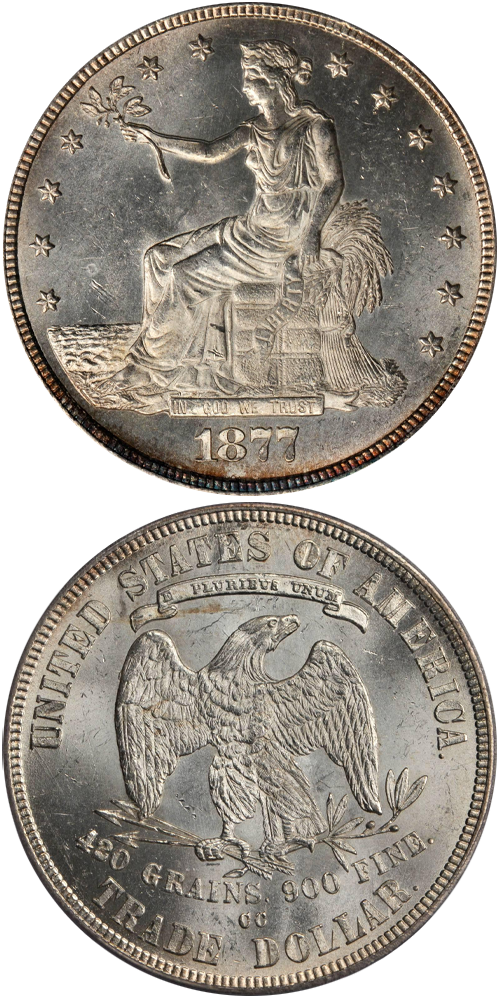1877-CC Trade Dollar
Rusty Goe: Trade dollar production at the Carson City Mint remained under suspension as 1877 began. The San Francisco branch continued to provide the bulk of the nation's supply of these large exchange-coins. Nevada's mining companies, the largest ones with strong business presences in San Francisco, sent huge amounts of their bullion to the California coast.
In January 1877, while the Carson Mint employees busied themselves with producing $256,000 face value in dimes, quarters, and halves -- no gold coins or trade dollars -- its California counterpart delivered its highest number of trade dollars to date: 1,082,000 pieces. This pace continued at San Francisco through May 1877, as trade dollar output there averaged 957,000 monthly.
Meanwhile at Carson City, the mint maintained a relatively brisk business in turning out subsidiary silver coins for the government's use in its specie resumption project.
Finally, toward the end of May, Coiner Levi Dague and his crew struck the first 30,000 Carson City trade dollars of 1877. The coining department did not officially deliver that batch until June, when during a five-day stretch early in the month it ran another 191,000 pieces through the press. This brought the total for their June delivery, just before the mint shut down for annual cleanup and settlement, to 221,000, the highest monthly output since January 1876.
The Carson Mint followed up in July with a delivery of 188,000 trade dollars, and then ended its brief three-and-a-half-month spurt in August by tapering off to 122,000 pieces. Its coining department did not strike trade dollars from September through November, and then delivered the final 3,000 specimens for the year in December. The Carson Mint's total of 534,000 put it slightly above its 1876 emission of trade dollars.
For coin collectors in the 21st century, a quick glance at the mintage figures would suggest that 1876-CC and 1877-CC trade dollars were equal in terms of survival populations. It appears, however, that the 1877-CC date, with its slightly higher original output, is narrowly rarer in all condition ratings than 1876-CC. If this is true, which seems beyond being provable, it is curious that the 1876-CC is much scarcer in grades MS-63 and above. Still, it is a challenge to find an exquisitely attractive 1877-CC trade dollar in any of the top Mint State categories.
Q. David Bowers: From a mintage for the 1877-CC of 534,000, Rusty Goe estimates that 450 to 750 exist in all grades, of which 75 to 100 are Uncirculated.
The Carson City Mint had not struck trade dollars since April 1876. For a time in June 1877 trade dollars were again minted. The Territorial Enterprise, published in Virginia City, reported on June 29: "The work of coining trade dollars will be briskly resumed at the Carson Mint July 1. The 'trades' are not for circulation here. They will be shipped to San Francisco, thence to China. Our people would not object to the big dollars just now, yet if they could get plenty of half dollars they will try to worry along."
By the end of August some 531,000 pieces had been struck at Carson City, and many pieces had found their way into circulation. On September 27, 1877 the Territorial Enterprise noted:
The shoe dealers in this city have all struck against the trade dollar. They all put up cards last evening containing the announcement: "Trade Dollars Not Taken" At some of the shoe stores they do not bother with them at all, while at others they are taken at 90 cents. Of late the 'trades' have been circulating to a considerable extent. It is supposed that the brokers were scattering them abroad for the purpose of coming down on them presently and buying them at a discount.
Although trade dollars were not liked by shoe stores in Virginia City, elsewhere in the United States they enjoyed newfound popularity while trading at a discount.
The example to the left was sold by Stack's Bowers Galleries in the August 2012 Battle Born Collection of Carson City Coinage, where it realized $23,500.






